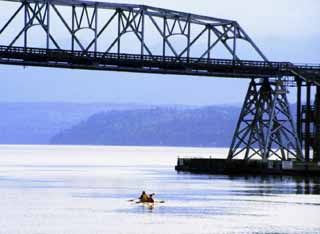
Surveys
DJC.COM
July 28, 2005
A solution to Hood Canal's lurking pollution?
Special to the Journal

Photo courtesy Puget Sound Action Team
Kayakers often ply the waters of Hood Canal, where Eagle Creek empties near the Hood Canal Bridge.
|
After years of water studies, a legislative infusion of $21 million is expected to begin cleaning up Hood Canal's polluted "dead zones," as well as many endangered areas on the verge of becoming uninhabitable for marine life.
There will be years of work ahead for environmental firms, septic system installers, engineers and construction contractors, among others. Those feeling the impact of the recovery effort will include homeowners, real estate agents, farmers, shellfish harvesters, recreational fishermen and Indian tribes who fish the canal commercially.
"We're delighted to have this funding available ... to continue some of the work started last year," said Ann Criss of the multi-agency Puget Sound Action Team in Olympia. "We think this funding will really make a difference. It can be very deceptive (for boaters, residents and motorists) to see this beautiful body of water. Below the surface, there really are hidden problems."
Rep. Bill "Ike" Eickmeyer, chair of the Legislature's House Select Committee on Hood Canal, calls the waterway "a very unique piece of water, the only true fjord in the United States." For six years he's been waving a red flag about the fish kills and deteriorating condition of the busy waterway that stretches 60 miles from Seattle to Olympia.
He said the family-owned Taylor Shellfish Farms in Shelton, a 100-year-old company, is also concerned about changing conditions in the canal.
|
"The shellfish industry is very supportive of anything we do to improve the health of the water in the canal".
"The largest shellfish company on the West Coast, Taylor has invested in their community and wants to protect natural resources as much as possible," he said.
Add the tourism industry to the list of those impacted by pollution problems in the canal waters, he said.
"A lot of people come here just for the Hood Canal. If things go wrong with it environmentally, it will have a big impact on tourism businesses," Eickmeyer said, which is one reason he's meeting during the summer with representatives of the University of Washington, Washington State University, Western Washington University and the Puget Sound Action Team to learn more about the canal's marine-life environment.
Basically, there is too little dissolved oxygen in Hood Canal to maintain its previously oxygen-rich environment for marine life. Researchers are just beginning to understand the nature of the canal's water-quality problems. But it's already clear that the volume of pollution from several sources could be dramatically reduced, or even eliminated, by taking immediate steps.
Recovery efforts will have an impact on the lives of hundreds of residents and businesses, who have contributed to the problem:
As recently as 2002, major numbers of fish and other marine life began dying in Hood Canal, attracting the attention of UW researchers and state environmental agencies. Because the fjord has limited natural cleansing from changing tides, algae growth spurred by increased nitrogen in the water began increasing. As the algae died, its decomposition removed more dissolved oxygen from the water.
Between 1990 and 2004, county records show that nearly 7,000 new homes were built in the lower Hood Canal watershed. In Belfair alone, at the eastern tip of the canal, there are grocery stores, restaurants, a laundromat, school and retail businesses on septic tanks.
Gov. Christine Gregoire requested $5 million in March to begin the effort to save Hood Canal's increasingly polluted waters. Along with legislative approval of that money, $16 million in additional funding was provided in the 2005-07 budget for Hood Canal cleansing projects through programs of the Department of Ecology; Department of Community, Trade and Economic Development; Department of Fish and Wildlife; Puget Sound Action Team; and the Mason County Conservation District.
So far, the $21 million includes $16 million to build a sewer system in Belfair; $1 million to design a sewer system for the Skokomish Tribe and city of Hoodsport; $1 million in low-interest loans to help repair failing septic tanks; $470,000 to identify failing septic systems; plus money for reducing livestock wastes and improving the disposal of salmon carcasses.
Also, in June, the Puget Sound Action Team received a $200,000 Natural Estuaries Program grant for continued development of a multi-stage plan to solve the canal's water quality issues.
Terry Stephens is a freelance writer based in Arlington. He can be reached by e-mail at features@gte.net.
Other Stories:
- Green buildings can spark economic growth
- Whitewater parks move into the mainstream
- Momentum is building to reduce global warming
- Turning waste into environmental, social good
- Let the sunshine in, efficiently
- The hazards of flicking on a light switch
- A road map for Columbia Basin's future
- Canada: A lesson in salmon recovery planning
- Better mapping may change development rules
- What makes a green consumer?
- Farmers, government team up to save fish
- Seattle law firms end their paper chase
- Food industry puts energy efficiency on the menu
- Stretching Washington's water supply
- Saving salmon: Now the hard work begins
- Seattle finds gold with sustainable strategies
Copyright ©2009 Seattle Daily Journal and DJC.COM.
Comments? Questions? Contact us.